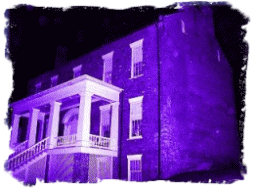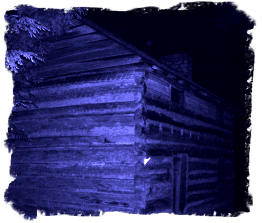|
|


One Tennessee's 2nd Oldest and Most Haunted Towns, Changing Hands 40 Times During the Civil War!!
| Learn about the unexpected happenings during our recent investigations of the Dickson-Williams Mansion. How many prisoners still linger inside Tennessee's oldest jail? Learn about the spirits who haunt a former United States President's home. Is General John Hunt Morgan haunting the historic district? |
| During the Greeneville GhostWalk you and your friends will visit the interior of several haunted and historic pre-civil war structures. You'll visit one of the areas most historic cemeteries to discover some of the area's |  |
 | grand and noble buried there. You'll learn about the tragic history of one of Tennessee's most influential political figures from the past. You'll also learn about one of our area's oldest taverns and be amazed by the tragic Civil War |
| entanglements of the town. Greeneville is a fascinating place with a deep rooted history and shares the distinction of being one of Tennessee's second oldest towns. We have learned to expect the unexpected on this tour as Greeneville is a town that changed hands |  |
| as many as forty times during the Civil War! Ending at the old Greeneville Jail built in 1804 where you may stand alone in the dark for sixty seconds, ongoing activity has been witnessed by many with this tour highly regarded as one of our spookiest towns!! |
The Greeneville Ghost Tour departs from behind the:
General Morgan Inn, 110 N Main St, Greeneville 37743
| Appalachian GhostWalks' "Haunted Historic Greeneville GhostWalk" Lantern-Led Tour operates year-round by request. Advance reservations online with a minimum of two participants in your party are required to reserve as follows... |
March through October  RESERVE NOW RESERVE NOW
Evening Lantern-Led Greeneville Ghost Tours Begin at 8:30 PM DST |
November through February  RESERVE NOW RESERVE NOW
Evening Lantern-Led Greeneville Ghost Tours Begin at 6 PM EST |
| Tours and dates are booked on a first come first served basis so it's a good idea to reserve your date as soon as possible. Keep in mind that if you book a tour and need to change the date, or even postpone your tour indefintely, you may do so as often as needed without limits, or change fees for up to one year from the date of purchase. By reserving your tour in advance, you're worry free knowing you will have the tour and date of choice for you and your travel companion, family, or tour group. |
|
Here Are a Few Reviews From Past Tour Guests
This is our second tour and we loved it! We live in Greeneville and really enjoyed hearing the history of the town. The guide was wonderful and made it all fun! - The Hinkle Family

We have done the Greeneville GhostWalk twice as well as the Appalachian GhostWalk tour of Jonesborough and I can't wait to book my next adventure. Full of history and excitement, the guides are amazing, and even my teenager is interested in the history lessons given by the guides. Thank you so much for the wonderful experiences. - Jennifer Alexander

Greeneville will never be the same!! I have always had a belief in the paranormal, albeit, with a little skepticism. However, after this experience, NO MORE!!! It was more than I could have ever bargained for and was a truly amazing experience, TWO THUMBS UP!!!!! I would recommend this experience to anyone who is simply looking for some fun to break up the monotony of life or for those looking for a truly paranormal experience! This is the last ghost walk you will ever need to take! - Kierney Jarvis

My husband and I did the all day ghost tour in Greeneville, TN. We actually live here and we found out things about out town that we never knew! The experience was amazing and it has changed my life. I had a positive experience that will stay with me forever!! I can't go into detail about it but will say that I look on the afterlife differently! Thank you Stacey Allen for this tour. I would recommend any one to take this tour, it was a night I'll never forget! - Mary and Eric

These are just a few of the many kind words expressed by our past guests. Read hundreds of other testimonials on the Guest Review page of our site. Many thanks to our wonderful past guests who we have toured with for more than twenty years. We appreciate you sending us your gracious feedback. We hope to see you again soon for another simply SPOOK-tacular good time!!! |

A Brief History of This Very Haunted and Historic Town
| Greeneville is a town in and the county seat of Greene County, Tennessee, United States. The population as of the 2020 census was 15,479. The town was named in honor of Revolutionary War hero Nathanael Greene, and it is the second oldest town in Tennessee. It is the only town with this spelling in the United States, although there are numerous U.S. towns named Greenville. The town was the capital of the short-lived State of Franklin in the 18th-century history of East Tennessee. |
| Greeneville is known as the town where United States President Andrew Johnson began his political career when elected to be an alderman and transitioned from his trade as a tailor. He and his family lived there for most of his adult years. It was an area of strong abolitionist and Unionist views and yeoman farmers, an environment that influenced Johnson's outlook. |
| GEOGRAPHY: Greeneville lies in the foothills of the Appalachian Mountains. These hills are part of the Appalachian Ridge-and-Valley Province, which is characterized by fertile river valleys flanked by narrow, elongate ridges. Greeneville is located roughly halfway between Bays Mountain to the northwest and the Bald Mountains— part of the main Appalachian crest— to the southeast. The valley in which Greeneville is situated is part of the watershed of the Nolichucky River, which passes a few miles south of the town. |
| Several federal and state highways now intersect in Greeneville, as they were built to follow old roads and trails. U.S. Route 321 follows Main Street through the center of the town and connects Greeneville to Newport to the southwest. U.S. Route 11E (Andrew Johnson Highway), which connects Greeneville with Morristown to the west, intersects U.S. 321 in Greeneville and the merged highway proceeds northeast to Johnson City. Tennessee State Route 107, which also follows Main Street and Andrew Johnson Hwy, Greeneville to Erwin to the east and to the Del Rio area to the south. Tennessee State Route 70 (Lonesome Pine Trail) connects Greeneville with Interstate 81, and Rogersville to the north and Asheville, North Carolina to the south. Tennessee State Route 172 (Baileyton Road) connects Greeneville with Interstate 81 and Baileyton to the north. |
| EARLY HISTORY: Native Americans were hunting and camping in the Nolichucky Valley as early as the Paleo-Indian period (c. 10,000 B.C.). A substantial Woodland period (1000 B.C. - 1000 A.D.) village existed at the Nolichucky's confluence with Big Limestone Creek (now part of Davy Crockett Birthplace State Park). By the time the first Euro-American settlers arrived in the area in the late 18th century, the Cherokee claimed the valley as part of their hunting grounds. The Great Indian Warpath passed just northwest of modern Greeneville, and the townsite is believed to have once been the juncture of two lesser Native American trails. |
| The permanent European settlement of Greene County began in 1772. Jacob Brown, a North Carolina merchant, leased a large stretch of land from the Cherokee, located between the upper Lick Creek watershed and the Nolichucky River, in what is now the northeastern corner of the county. The "Nolichucky Settlement" initially aligned itself with the Watauga Association as part of Washington County, North Carolina. After voting irregularities in a local election, however, an early Nolichucky settler named Daniel Kennedy (1750–1802) led a movement to form a separate county, which was granted in 1783. |
| The county was named after Nathanael Greene, reflecting the loyalties of the numerous Revolutionary War veterans who settled in the Nolichucky Valley, especially from Pennsylvania and Virginia. The first county court sessions were held at the home of Robert Kerr, who lived at "Big Spring" (near the center of modern Greeneville). Kerr donated 50 acres (0.20 km2) for the establishment of the county seat, most of which was located in the area currently bounded by Irish, College, Church, and Summer streets. "Greeneville" was officially recognized as a town in 1786. |
| State of Franklin: In 1784, North Carolina attempted to resolve its debts by giving the U.S. Congress its lands west of the Appalachian Mountains, including Greene County, abandoning responsibility for the area to the federal government. In response, delegates from Greene and neighboring counties convened at Jonesborough and resolved to break away from North Carolina and establish an independent state. The delegates agreed to meet again later that year to form a constitution, which was rejected when presented to the general delegation in December. |
| Reverend Samuel Houston (not to be confused with the later governor of Tennessee and Texas) had presented a draft constitution that restricted the election of lawyers and other professionals. Houston's draft met staunch opposition, especially from Reverend Hezekiah Balch (1741–1810) (who was later instrumental in the creation of Tusculum College). John Sevier was elected governor, and other executive offices were filled. |
| A petition for statehood for what would have become known as the State of Franklin (named in honor of Benjamin Franklin) was drawn at the delegates session in May 1785. The delegates submitted a petition for statehood to Congress, which failed to gain the requisite votes needed for admission to the Union. The first state legislature of Franklin met in December 1785 in a crude log courthouse in Greeneville, which had been named the capital city the previous August. During this session, the delegates finally approved a constitution that was based on, and quite similar to, the North Carolina state constitution. However, the Franklin movement began to collapse soon thereafter, with North Carolina reasserting its control of the area the following spring. |
| In 1897, at the Tennessee Centennial Exposition in Nashville, a log house that had been moved from Greeneville was displayed as the capitol where the State of Franklin's delegates met in the 1780s. There is, however, nothing to verify that this building was the actual capitol. In the 1960s, the capitol was reconstructed, based largely on the dimensions given in historian J. G. M. Ramsey's Annals of Tennessee. |
| Greeneville and the abolitionist movement: First Presbyterian Church, founded by Rev. Hezekiah Balch and Samuel Doak in 1780
Greene County, like much of East Tennessee, was home to a strong abolitionist movement in the early 19th century. This movement was likely influenced by the relatively large numbers of Quakers who migrated to the region from Pennsylvania in the 1790s. The Quakers considered slavery to be in violation of Biblical Scripture and were active in the region's abolitionist movement throughout the antebellum period. One such Quaker was Elihu Embree (1782–1820), who published the nation's first abolitionist newspaper, The Emancipator, at nearby Jonesborough. |
| When Embree's untimely death in 1820 effectively ended publication of The Emancipator, several of Embree's supporters turned to Ohio abolitionist Benjamin Lundy, who had started publication of his own antislavery newspaper, The Genius of Universal Emancipation, in 1821. Anticipating that a southern-based abolitionist movement would be more effective, Lundy purchased Embree's printing press and moved to Greeneville in 1822. Lundy remained in Greeneville for two years before moving to Baltimore. He would later prove influential in the career of William Lloyd Garrison, whom he hired as an associate editor in 1829. |
| Greenevillians involved in the abolitionist movement included Hezekiah Balch, who freed his slaves at the Greene County Courthouse in 1807. Samuel Doak, the founder of Tusculum College, followed in 1818. Valentine Sevier (1780–1854), a nephew of John Sevier who served as Greene County Court Clerk, freed his slaves in the 1830s and offered to pay for their passage to Liberia, which had been formed as a colony for freed slaves. Francis McCorkle, the pastor of Greeneville's Presbyterian Church, was a leading member of the Manumission Society of Tennessee. |
| Civil War: Artist's depiction of a Union soldier firing the shots that killed General John Hunt Morgan in Greeneville in 1864
In June 1861, on the eve of the Civil War, thirty counties of the pro-Union East Tennessee Convention met in Greeneville to discuss strategy after state voters had elected to join the Confederate States of America. The convention sought to create a separate state in East Tennessee that would remain with the United States. The state government in Nashville rejected the convention's request, however, and East Tennessee was occupied by Confederate forces shortly thereafter. Thomas Dickens Arnold, a Greeneville resident and former congressman who attended the convention, advocated the use of violent force to allow East Tennessee to break away from Tennessee, and taunted other members of the convention who advocated a more peaceful set of resolutions. |
| Several conspirators involved in the pro-Union East Tennessee bridge burnings lived near what is now Mosheim, and managed to destroy the railroad bridge over Lick Creek in western Greene County on the night of November 8, 1861. Two of the conspirators, Jacob Hensie and Henry Fry, were executed in Greeneville on November 30, 1861. A portion of James Longstreet's army wintered in Greeneville following the failed Siege of Knoxville in late 1863. Confederate general John Hunt Morgan was killed in Greeneville during a raid by Union soldiers led by Alvan Cullem Gillem on September 4, 1864. |
| Andrew Johnson: Andrew Johnson, the 17th President of the United States, spent much of his active life in Greeneville. In 1826, Johnson arrived in Greeneville after fleeing an apprenticeship in Raleigh. Johnson chose to remain in Greeneville after learning that the town's tailor was planning to retire. Johnson purchased the tailor shop, which he moved from Main Street to its present location at the corner of Depot and College streets. Johnson married a local girl, Eliza McCardle, in 1827. The two were married by Mordecai Lincoln (1778–1851), who was Greene County's Justice of the Peace. He was a cousin of Abraham Lincoln, under whom Johnson would serve as vice president. |
| In the late 1820s, a local artisan named Blackstone McDannel often stopped by Johnson's tailor shop to debate issues of the day, especially the Indian Removal, which Johnson opposed. Johnson and McDannel decided to debate the issue publicly. The interest sparked by this debate led Johnson, McDannel, and several others to form a local debate society. The experience and influence Johnson gained in debating local issues helped him get elected to the Greeneville City Council in 1829. He was elected mayor of Greeneville in 1834, although he resigned after just a few months in office to pursue a position in the Tennessee state legislature, which he attained the following year. As Johnson rose through the ranks of political office in state and national government, he used his influence to help Greeneville constituents obtain government positions, among them his long-time supporter, Sam Milligan, who was appointed to the Court of Claims in Washington, D.C. |
| Whilst Andrew Johnson was away from home, during his vice-presidency, both Union and Confederate armies often used his home as a place to stay and rest during their travel. Soldiers left graffiti on the walls of Johnson's home. Confederate soldiers left notes on the walls expressing their displeasure, to put it delicately, of Johnson. Evidence of this can still be seen at the Andrew Johnson home. Andrew Johnson had to almost completely renovate his home after he returned home from Washington, D.C. |
| The Andrew Johnson National Historic Site, located in Greeneville, was listed on the National Register of Historic Places in 1963. Contributing properties include Johnson's tailor shop at the corner of Depot and College streets. The site also maintains Johnson's house on Main Street and the Andrew Johnson National Cemetery (atop Monument Hill to the south). A replica of Johnson's birth home and a life-size statue of Johnson have been placed across the street from the visitor center and tailor shop. |
| Indian Wars: Buffalo Soldiers originally were members of the 10th Cavalry Regiment of the United States Army, formed on September 21, 1866, at Fort Leavenworth, Kansas. This nickname was given to the Black Cavalry by Native American tribes who fought in the Indian Wars. The term eventually became synonymous with all of the African-American regiments formed in 1866. Greeneville was home to at least four men who bravely served the country as "Buffalo Soldiers". |
| George Clem School: In 1887, with assistance from the African Methodist Episcopal Zion Church, the George Clem School was organized as Greeneville College. In 1932, the Greeneville Board of Education leased the property to provide public education for Negroes. Three years later, George Clem was appointed principal. Consisting of grades one through ten, the school was renamed Greeneville College High School. In 1937, the 11th grade was added. A year later, the school became an accredited four-year school. In 1939, the city purchased the school and renamed it the George Clem School. A decade later, the original building was demolished and the present building was erected in 1950. The school closed in 1965 when the public schools desegregated, and it became the location of the Greeneville City Schools Central Office. |
| The George Clem School is often overlooked when talking about Greeneville history. Topics such as Sam Doak, the death of General Morgan, and Andrew Johnson are often the focal points when learning about Greeneville. The George Clem School is something the town should promote and be proud of. This history shows the accomplishments of the black community in Greeneville through the years. There is now a non profit organization in Greeneville by the name of George Clem Multicultural Alliance that helps honor the history of the school. The George Clem Multicultural Alliance is a non-profit 501(c)(3), public benefit, & exclusively charitable organization dedicated to supporting civic pride & cultural diversity awareness through various means within Wesley Heights community, and Greeneville/Greene County at large. |
| Magnavox: From 1947 to 2005, Magnavox—an electronics manufacturer best known for its television sets—operated its main three facilities in Greeneville. Magnavox was at one time the largest employer of Greeneville, employing more than 5,000 workers. Eight years after the first plant opened, Magnavox workers voted to form a union through the IBEW. In 1974, the facilities and the Magnavox company were acquired by the electronics giant Philips. Throughout the 1980s and early 1990s, the Greeneville facility saw a fluctuation and drops in employment. In 1997, Phillips sold its facilities to Knoxville-based company Five Rivers Electronic Innovations. In 2005, Five Rivers closed the former Magnavox plant after declaring bankruptcy. Before its shuttering, the Five Rivers facility was the site of the last television manufactured in the United States, which is now on display in the Greeneville-Greene County History Museum. |
| 2011 tornado outbreak: On April 27, 2011, the rural community of Camp Creek south of Greeneville was severely affected by an EF3 tornado in the 2011 Super Outbreak. Six people were killed and 220 were injured by the tornado that either damaged or destroyed over 175 homes. Two hours later, Horse Creek, southeast of Greeneville, was also hit by an EF3 tornado, with the path travelling alongside and later crossing the earlier Camp Creek event as it moved into Washington County. Another 60-65 homes were either damaged or destroyed, and around 25 farms sustained heavy structural damage. Two more people were killed by that tornado, with an estimated 70 more being injured. A total of seven were killed in Greene County, with an eighth fatality in Washington County. |
| Downtown revitalization: In 2018, town officials, with the cooperation of a development and urban design firm, began efforts towards the redevelopment of the central business district of Greeneville. The project is projected to operate in several phases, projects proposed include: a farmer's market pavilion, a greenway along Richland Creek, an alley park, improved access for pedestrians and cyclists, parking garages, and the conversion of Depot Street into a street fair area. In October 2021, construction work began on a complete street-approach to Depot Street between Main Street and Irish Street in downtown Greeneville with enhanced pedestrian access. The project was completed in November 2023. |


|
|